
 |
 |
 |
 |
 |
Preface to the History
I would like to preface this history section with a comparison of the advancement of cars to the advancement of "ass-care" products.

Granted that I am comparing toilet paper to automobiles (two products which usually have very different purposes), one can see that other than packaging and quality of paper, there hasn't been much out of the box (or should I say, off of the roll) thinking in the last 150 years. This revelation was made first by Seinfeld in "The Face Painter" Episode:
Jerry: Toilet paper?
George: Yeah, I told her how toilet paper hasn't changed in my lifetime, and
probably wouldn't change in the next fifty thousand years and she was
fascinated, fascinated!Jerry: What are you talking about?
Elaine: Yeah.
Jerry: Toilet paper's changed.
Elaine: Yeah.
Jerry: It's softer.
Elaine: Softer.
Jerry: More sheets per roll
Elaine: Sheets.
Jerry: Comes in a wide variety of colors.
Elaine: Colors.
George: Ok, ok, fine! It's changed, it's not really the point.
The History of Toilet Paper (and its Equivalents)
Pre-50BC (Natural tools)
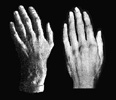 |
 |
 |
It is believed that the first materials used for cleaning were sticks and leaves. Islamic tradition prescribes the wiping with stones and earth and rinse with water. In colder lands, snow was used. A friend, who tested this method claims that:
At the time I only used snow out of desperation, but now that I think about
it, it's probably one of the most sanitary if available. The coldness was not as
striking as I'd have thought, and I suppose if someone used snow on a daily
basis, they'd grow accustomed. Snow can also be packed together in case that
makes a difference to some people.I don't think I want my name attached to the blurb.
In India, Africa and the Arab lands the left hand with water was a common cleaning implement. The hand would be cleaned shortly after. This method is still in use in some developing countries. A friend, who recently spent some time in Africa commented on this method:
In Africa, on the other hand, when you go to the latrine (which is just a hole in the ground surrounded by two, three, or four walls), you take a little plastic teapot filled with water and a plastic colander-type thing that holds your soap. I'm speculating that both of these things (the teapot & the colander) were introduced by colonists and I find it endlessly beautiful that Africans use those teapots in the way that makes sense to them, rather than for tea & crumpets at 4 PM.
In the end I feel like it's actually MORE sanitary to wipe your ass with your hand, because you're not gonna be under the illusion that there's no s*** on it.
Some historians believe that the use of the left hand for wiping is the reason why we shake with our right hand.
50BC- Middle Ages (Cloth, wool and hay)
 |
 |
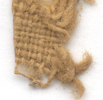 |
 |
In ancient Rome, the public toilets were supplied with a sponge attached
to the end of a stick. This sponge was soaked in a bucket of brine. The
wealthier Romans of the time used wool and rosewater. The wealthy French
used lace, wool and hemp. In the Middle Ages they used hay balls and a
scraper stick kept in a container.
Late 14th Century- Late 19th Century (Shift to paper products)
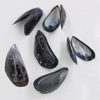 |
 |
 |
 |
The first account of toilet paper (paper made for this specific purpose) was in 1391 by the Chinese emperors. This toilet paper was made in 2-foot by 3-foot sheets. This toilet paper was produced by the Bureau of Imperial Supplies at the rate of 720,000 sheets per year. It was also in this time period that the French invented the bidet for the rinsing of both sexes. Defecating in the river was also a very common practice.
In the Colonial America, the common means was corncobs until the 1700s when newspapers became available. In areas along the coastline or tropics, mussel shells and coconut shells were popular. Following newspapers, the Sears catalog and the Farmers almanac were the most popular form of toilet paper. The Farmer's Almanac even had a hole in it so it could be hung near the toilet. The use of the Sears catalog declined in the 1930's when Sears began printing on glossy, clay-coated paper (making it less absorbent). Many people complained.
1857-1999. (Toilet Paper)
 |
 |
 |
 |
In 1857 the first Toilet Tissue was developed by Joseph Gayetty of New York. This "Therapeutic Paper" was sold in packages of 500 sheets for $.50. "Gayetty's Medicated Paper" contained aloe and was marketed as a means to cure sores and prevent piles (hemorrhoids). His name was printed on each sheet. In 1880, the British Perforated Paper Company began producing toilet paper. These papers were individual squares sold in boxes and were very coarse.
In 1890, the Scott Paper Company of Philadelphia introduced perforated toilet paper on a roll and they quickly becomes the nation's leading producer of toilet paper. At first, their toilet paper was sold through intermediaries, private labelers and drug stores as they did not want to be associated with this "unmentionable" product. The owners did not want their name on the product, so in 1902 they went by the name "Waldorf."
In the 1930 Northern Tissue developed a means of producing toilet paper without leaving the occasional splinter in the paper. This "Splinter-free" toilet paper made Northern a popular brand.
1942 - two ply toilet tissue by St. Andrews Paper Mill
in England
1954 - colored toilet tissue by Northern
1964 - perfume to the one-ply toilet tissue by Charmin
1973 - Charmin patents a process to make toilet paper softer by air drying instead of squeezing the paper. This was also the year that Johnny Carson started the great Toilet Paper Shortage Scare when he made a joke about a shortage of toilet paper, which actually led to a shortage of toilet paper.
1999 - Charmin introduces new "structured" papermaking process which makes paper softer, more absorbent and stronger.
1999-Present (Water, Toilet Paper (still), and Toilet Paper with Water)
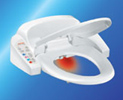 |
 |
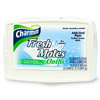 |
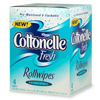 |
In 1999 the "paperless toilet" is introduced in Japan. These toilets contain a washing/rinsing mechanism, a blow-drying component and a heating element. In 2001 in the United States, the pre-moistened toilet paper was introduced by Kimberly Clark. Cottenelle released "Fresh Rollwipes" which were not successful, and so Charmin re-released them under the name "Fresh Mates".
Many of the dates in this History are referenced from Toiletpaperworld.com